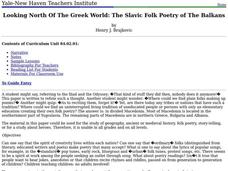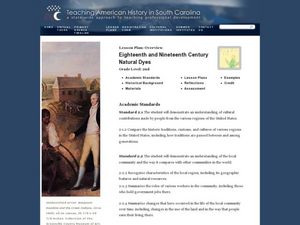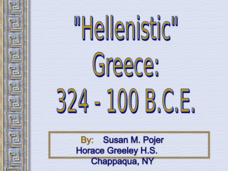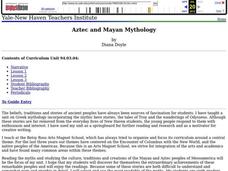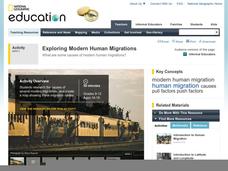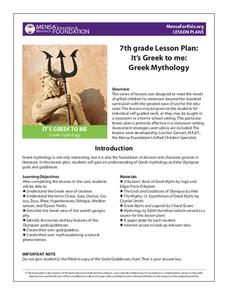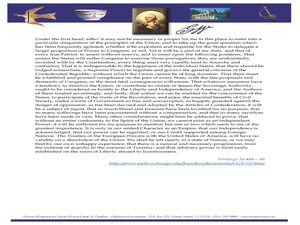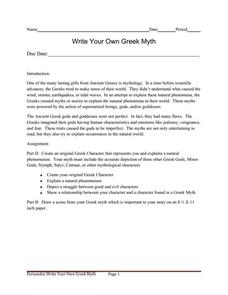Curated OER
Elements of Myth
Students read and act out myths. In this world mythology lesson, students read and analyze myths from various cultures and then recognize their attributes as they prepare presentations of myths that explain natural phenomena.
Curated OER
Greco-Roman Origin Myths
Learners explore myths that explain the world, recognize some characters of Greco-Roman mythology and their symbols, and Make personal connections to the theme by writing and drawing a myth of their own.
Curated OER
Final Regents Review: Greece
Take your students on a free trip to Athens this year with this presentation, which tours the geography, history, and modern changes in the country of Greece. Clear, easy-to-understand maps and pictures help students to appreciate this...
Cyberwise
Good Digital Citizenship Outdoors
It's easy to miss the beauty of nature when one's focus is on technology. Don't make that mistake with help from a two-page reference sheet that provides eight tips for staying present when exploring the world around you.
Curated OER
Looking North Of The Greek World: The Slavic Folk Poetry of The Balkans
Showing how folk poetry keeps alive national heritage is the stated goal of this proposal for a unit on the poetry of the Balkans.
Curated OER
Eighteenth and Nineteenth Century Natural Dyes
Second graders explore the work of Americans when it came to coloring materials. In this interdisciplinary instructional activity, 2nd graders follow the provided steps to make natural goldenrod dye from scratch.
Curated OER
Alexander the Great and Hellenistic Greece
Visual images, maps, and notes on the great philosophers and scientists of Hellenistic Greece await your class. While light in terms of text, the presentation provides images that should help you to describe the area and reign of...
Wildwood Trust
Habitats
The circle of life is all around us, from the black bears in the nearby mountains to the pile of dead leaves in the backyard. Encourage young scientists to take a critical look at the world around them with a set of lessons...
Curated OER
Urban Ecosystems 2: Why are There Cities? A Historical Perspective
Second in a series of five lessons, this lesson encourages preteens to consider cities as urban ecosystems. First, they keep a food diary for a few days. They visit the Natrional Agricultural Statistics Service website for current data...
Curated OER
Ancient Mediterranean Trade Fair
Sixth graders begin the lesson by discussing how artifacts are located. In groups, they define the terms supply, demand, resources and trade and discuss how the United States is affected by International trade. They use this...
Curated OER
Ancient Cities
Learners discuss ways homes, buildings and cities are designed for a particular climate and geography. Students use a chart and conduct library and online research to explore ways the Mayans and Incas developed their land based on their...
Curated OER
Exchange of Goods and Ideas in the Ancient Mediterranean
Ninth graders begin the lesson by discussing and locating the trade routes in the Mediterranean. Using pieces of pottery and coins, they discuss how it shows the culture of an area and create a chart showing the value of the coins. ...
Curated OER
Medicine: Then and Now
Students read ancient Greek texts to explore ancient healing practices and compare them to those of modern times. They explain Greek healing practices for wounds.
Curated OER
Medicine: Then and Now
Students read ancient Greek texts to explore ancient healing practices and compare them to modern-day medicine. They conduct research into modern first-aid practices, using a standard medical reference.
Curated OER
Icon Adoration: The Byzantine Empire
Students study idol worship in the Byzantine Empire and the separation it cause between the Roman Catholic and Orthodox churches. In this Byzantine Empire lesson, students study pictograph transparencies and take a pop quiz over them....
Curated OER
Africa Test Study Guide
In this Africa study guide worksheet, students respond to 27 short answer questions about the geography and history of the continent.
Curated OER
Aztec and Mayan Mythology
Here's a fresh take on a mythology unit. Use the myths of the Mayan and Aztec peoples of Mesoamerica instead of the more traditional Greek and Roman stories. This abstract suggests possible approaches and resources that can be...
Curated OER
The World's Newest Landmark
In this reading comprehension activity, students read a 6-paragraph article about the tallest building the world, the Burj Khalifa. Students respond to 6 short answer questions. Vocabulary words and definitions are included.
Curated OER
The New Organon
In this online interactive history worksheet, students respond to 10 short answer and essay questions about Francis Bacon's The New Organon. Students may check some of their answers on the interactive worksheet.
National Geographic
Exploring Modern Human Migrations
Using maps, images, websites, and handouts, learners work to understand the nature of human migrations. They compare and contrast human migration from the past to the present, identify causes for migration, and trace migration routes on...
Curated OER
It’s Greek to Me: Greek Mythology
Here you'll find a great collection of worksheets to supplement your instruction of Greek mythology, including informational texts on the Olympian gods and goddesses, a matching quiz, graphic organizers, and myth-writing activities.
Curated OER
George Washington & the Classics
Students will compare and contrast famous philosophers with George Washington. For this history lesson, students work in small groups to define Classicism, Legalism, Democracy, Republic and Civility, then read some short excerpts...
Frost Middle School
Write Your Own Greek Myth
Invite your pupils to create original Greek characters and myths for their characters to star in. Similar to a traditional Greek myth, the story must explain a natural phenomenon, depict a struggle between good and evil characters, and...
American Museum of Natural History
Fossils
Sixteen slides showcase an average day on the job for a paleontologist, Ross MacPhee. Engaging images include world maps and real-world photographs from an archeological dig in Antarctica. A brief description accompanies each slide.






